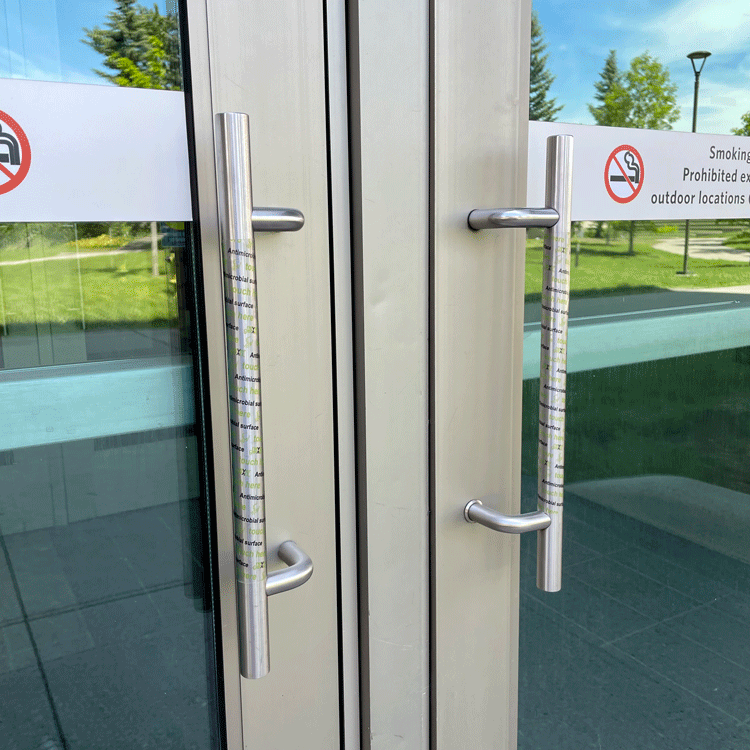Frequently Asked Questions
What are NeverGerms® Antimicrobial Surface Covers?
Made in the USA, NeverGerms® antimicrobial covers are designed to create cleaner and safer surfaces. Easy to apply and safe to use, NeverGerms covers reduce microbes on high-touch areas, decreasing daily exposure by touch contact. Once applied, antimicrobial protection happens 24 hours a day, 7 days a week, and lasts up to 6 months!
NeverGerms antimicrobial surface covers are available in various shapes and sizes, based on application. NeverGerms products are Polymer-based, Latex-free and designed to be used in conjunction with common industrial cleaners.
Benefits of NeverGerms® Antimicrobial Covers
Apply once and the surface will continually self-sanitize 24 hours a day for up to 6 months at a time
Cost-effective solution in comparison to consistent cleaning/janitorial crews wiping down surfaces
NeverGerms antimicrobial covers work continuously versus cleaning products and disinfectants, many of which have short effective periods
NeverGerms EPA-registered additive is proven effective against a broad spectrum of bacteria, even resistant strains of MRSA
NeverGerms antimicrobial film is EPA-compliant, FDA-compliant, EFSA-compliant, GRAS, RoHS, and latex-free
NeverGerms antimicrobial technology does not wash off
Antimicrobial covers are suitable for both indoors and outdoors
NeverGerms high-visibility pattern denotes which areas are protected using antimicrobial technology and are self-sanitizing,
Antimicrobial covers provide visual assurance of cleanliness and protection, and offers peace of mind
Where can you apply NeverGerms® antimicrobial covers?
Pretty much anywhere you want antimicrobial protection! Hand railings, door handles, elevator buttons, bathroom entrances and fixtures, desks and tables, D-pull door handles, crash bars, push and pull bars, handicap access buttons, swinging doors, escalators, small handles and latches, light switches, lever handles, and more! We even have 2” and 4” rolls for those who want to cut and customize their own shape.
What are NeverGerms® antimicrobial covers shielded against?
NeverGerms products use an EPA registered antimicrobial additive in our proprietary coating which kills 99.9% of microbes, including MRSA. NeverGerms® ionic antimicrobial technology is effective against:
Streptococci (pneumonia, meningitis, strep throat, rheumatic fever, impetigo, scarlet fever)
Staphylococci (MRSA, endocarditis, TSS)
E-coli (food poisoning)
Influenza (H1N1, swine flu)
Human coronavirus NL63
Rhinovirus (common cold)
Trichophyton (athlete’s foot, ringworm)
Allergy-inducing molds & more…
We perform ongoing quality performance tests using methods endorsed by the CDC, developed by the Clinical Laboratory Standards Institute (CLSI) to assure product performance. To find out more about the efficacy of NeverGerms, please send an email to sales@nevergerms.com
How do you apply NeverGerms® antimicrobial film?
It’s simple! Just clean the surface, peel the backing off, and apply the antimicrobial cover. You have now protected the surface with antimicrobial self sanitizing technology. Done. Just like that!
Who can use NeverGerms? What are the smartest places to utilize NeverGerms self-sanitizing covers?
Anyone, big or small! Common locations NeverGerms are used include store entrances, offices, businesses, residential and commercial properties, schools and educational institutions, bathrooms, gyms and locker rooms, restaurants and bars, transportation, and more!
What is Antimicrobial Technology?
The EPA defines antimicrobial pesticides as “substances or mixtures of substances used to destroy or suppress the growth of harmful microorganisms such as bacteria, viruses, or fungi on inanimate objects and surfaces”.
NeverGerms antimicrobial technology is constructed from proven components, with global safety certifications.
How long do NeverGerms® antimicrobial products last?
Product life is determined exclusively by product wear. We recommend replacing every 6 months. In some high traffic applications, they may need to be replaced more often. The surface cover will remain active, even if scratched or nicked. If the cover starts to peel off we recommend replacement.
Can I clean NeverGerms® products?
NeverGerms products are designed to work in harmony with daily cleaning and disinfecting routines. Simply apply common commercial cleaning or disinfecting solutions directly to the surface covers and clean along with the non-covered areas.
Where are NeverGerms® products made?
NeverGerms products are made in the USA, so we can assure the highest quality.
Where can I buy NeverGerms® antimicrobial covers?
Shop online at shop.nevergerms.com
Do you private label the surface covers? Can we put our own brand on them?
Yes, private labeling is possible. Please send an email to sales@nevergerms.com with your requirements and a member of the NeverGerms team will be in contact.
Interested in being an independent manufacturers representative of NeverGerms® antimicrobial surface covers?
Send an email to sales@nevergerms.com and we will be in contact shortly.




